The Rosary Devotional
Multi Auctores
THE name Rosary signifies a crown of roses; and well does this devotion deserve, by just right, a name so beautiful. The rose is the most beautiful of flowers and ravishes our senses with its beauty and perfume; and there is no delight that can equal the heavenly enchantment of the spiritual sweetness which is exhaled from this beautiful prayer.
The Rosary is a spiritual garland of mystic roses with which we deck the brow of Mary—a diadem which reflects the joy and brilliance, the purity and fecundity of the glorious Queen of Heaven.
The flowers which we weave are not of this earth, but are indigenous to Paradise, and were transplanted by an angel's hand from their native soil to bloom and flourish among the weeds and thistles of this miserable and sinful world.
There is no form of prayer more efficacious, or more excellent and acceptable before Heaven, than Mary's own devotion, the Rosary. There is nothing that the great Holy Father, Pope Leo XIII, urged more upon the Church than the devout practice of reciting the beads in her honor.
The devotion of the Holy Rosary was revealed to St. Dominic by the Blessed Virgin Mary, who commanded him to preach it throughout the world; and hence the Rosary has ever been the spiritual heritage and distinct property of the Dominican Order.
The Rosary is adapted to the learned and the ignorant, and to every capacity. The form and matter are intelligible to the most illiterate, and yet so sublime as to be matter of contemplation worthy of the highest intellect. Moreover, the Rosary is not only a most sublime and perfect devotion, but there is no devotion in the Church which is enriched with more precious and valuable helps to salvation; and there is nothing, outside the Holy Sacrifice, that can profit the living and the dead equal to the pious recitation of the Rosary.
The Rosary consists in the recitation, in honor of the Most Holy Virgin Mary, Mother of God, of the Angelic Salutation one hundred and fifty times, distributed into fifteen decades; each decade being preceded by the Lord's Prayer and accompanied by meditation on one of the principal mysteries of our Divine Saviour and terminated by the doxology or "Glory be to the Father," etc. The vocal prayer is the matter, the body of this exercise; the meditation on the fifteen mysteries is the form, and, as it were, the soul of this prayer. The Rosary is divided into three parts; each part contains five mysteries and is called a chaplet. The first part consists of the five joyful mysteries; the second, of the five sorrowful; and the third, of the five glorious mysteries.

- On the cross: Pray the Apostle's Creed.
- On the first bead above the cross: Pray the Lord's Prayer (Our Father).
- On each of the following three beads: Pray the Angelic Salutation (Hail, Mary).
- On the cord or chain following the three beads: Pray the Trinitarian Doxology (Glory Be).
- On the next bead: Announce the first mystery, then pray the Lord's Prayer (Our Father).
- On each of the next ten beads, going counterclockwise: Pray the Angelic Salutation (Hail, Mary), meditating on the first mystery.
- On the cord following the tenth bead: Pray the Trinitarian Doxology (Glory Be) and the Fatima Prayer (O my Jesus). Repeat 5–7 for all five mysteries.
- On the medal where the circle meets the tail: Pray the Hail, Holy Queen; the Rosary Prayer; the Prayer to St. Michael; and the Lord's Prayer, Angelic Salutation, and Trinitarian Doxology for the intentions of the Holy Father, the Pope.
I believe in God, the Father Almighty, Creator of heaven and earth. And in Jesus Christ, His only Son, Our Lord; Who was conceived by the Holy Spirit, born of the Virgin Mary, suffered under Pontius Pilate, was crucified, died, and was buried. He descended into hell; on the third day He rose again from the dead. He ascended into heaven and is seated at the right hand of the Father; from thence He shall come to judge the living and the dead. I believe in the Holy Spirit, the Holy Catholic Church, the communion of saints, the forgiveness of sins, the resurrection of the body, and life everlasting. Amen.
Our Father, Who art in heaven, hallowed by Thy Name. Thy kingdom come; Thy will be done, on earth, as it is in heaven. Give us this day our daily bread, and forgive us our trespasses, as we forgive those who trespass against us. And lead us not into temptation, but deliver us from evil. Amen.
Hail Mary, full of grace; the Lord is with thee. Blessed art thou amongst women, and blessed is the fruit of thy womb, Jesus. Holy Mary, Mother of God, pray for us sinners, now and at the hour of our death. Amen.
Glory be to the Father, and to the Son, and to the Holy Spirit. As it was in the beginning, is now, and ever shall be, world without end. Amen.
Oh, my Jesus, forgive us our sins; save us from the fires of hell. Lead all souls to heaven, especially those in most need of Thy mercy.
Hail, Holy Queen, Mother of mercy, our life, our sweetness, and our hope! To thee do we cry, poor banished children of Eve. To thee do we send up our sighs, mourning and weeping in this valley of tears. Turn then, most gracious advocate, thine eyes of mercy upon us; and after this, our exile, show unto us the blessed fruit of thy womb, Jesus. O clement, O loving, O sweet Virgin Mary!
℣. Pray for us, O Holy Mother of God.
℟. That we may be made worthy of the promises of Christ.
Let us pray. O God, Whose only-begotten Son, by His life, death, and resurrection, has purchased for us the rewards of eternal life; grant, we beseech Thee; that, meditating upon these mysteries in the most holy Rosary of the Blessed Virgin Mary, we may imitate what they contain and obtain what they promise. Through the same Christ Our Lord. Amen.
Saint Michael the Archangel, defend us in battle; be our protection against the wickedness and snares of the Devil. May God rebuke him, we humbly pray; and do thou, O prince of the heavenly host, by the power of God, cast into hell Satan and all the evil spirits who prowl about the world seeking the ruin of souls. Amen.
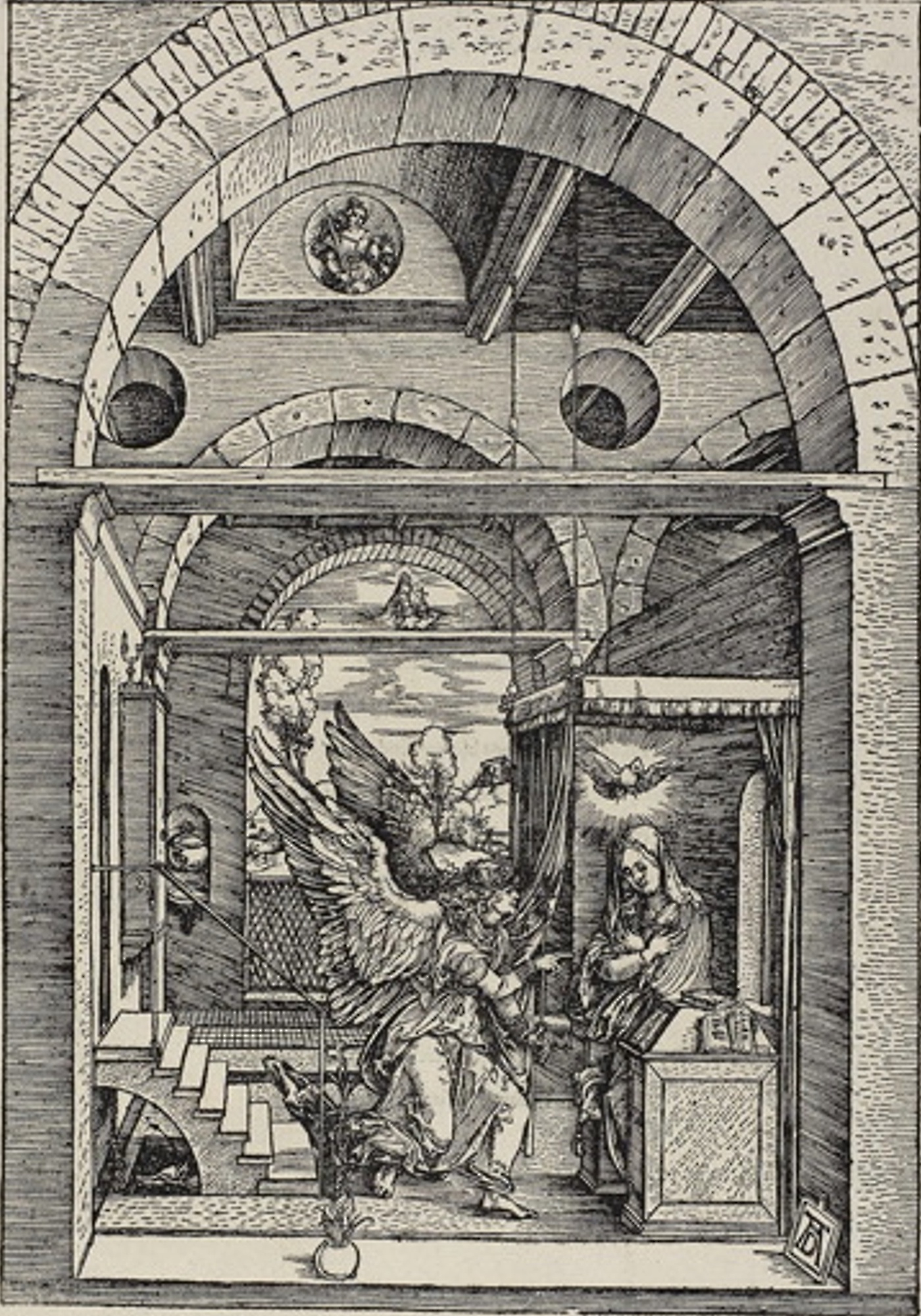
As Jesus, the Savior of Mankind, humbled himself, becoming obedient even unto the death of the Cross, how fitting that Mary, his Mother, should in the moment of her greatest exaltation teach us the lesson of Humility.
Pride wrought the ruin of legions of angels; through pride our first parents sinned in the Garden of Happiness. By humility our salvation was achieved—the humility of the Word of God. In our pride we have disobeyed God's holy law. Through humble penance are we to regain God's favor.
In Latin, the Archangel Gabriel said to Our Lady Ave, “Hail.” The name of Eve in Latin is Eva, the same letters in the reverse order. The liturgy and spirituality of the Church has long employed this reversal---the new Eve's Ave and the old Eve's Eva---as deeply symbolic. Consider the verse of the Ave Maris Stella:
or in English,
By saying Ave to the new Eva, then, we give honor to the new Eve's reversal of the old Eve's fault; to her “yes” as opposed to Eve's “no.” O Mary, humble hand-maid of the Lord, pray that we know our own unworthiness!
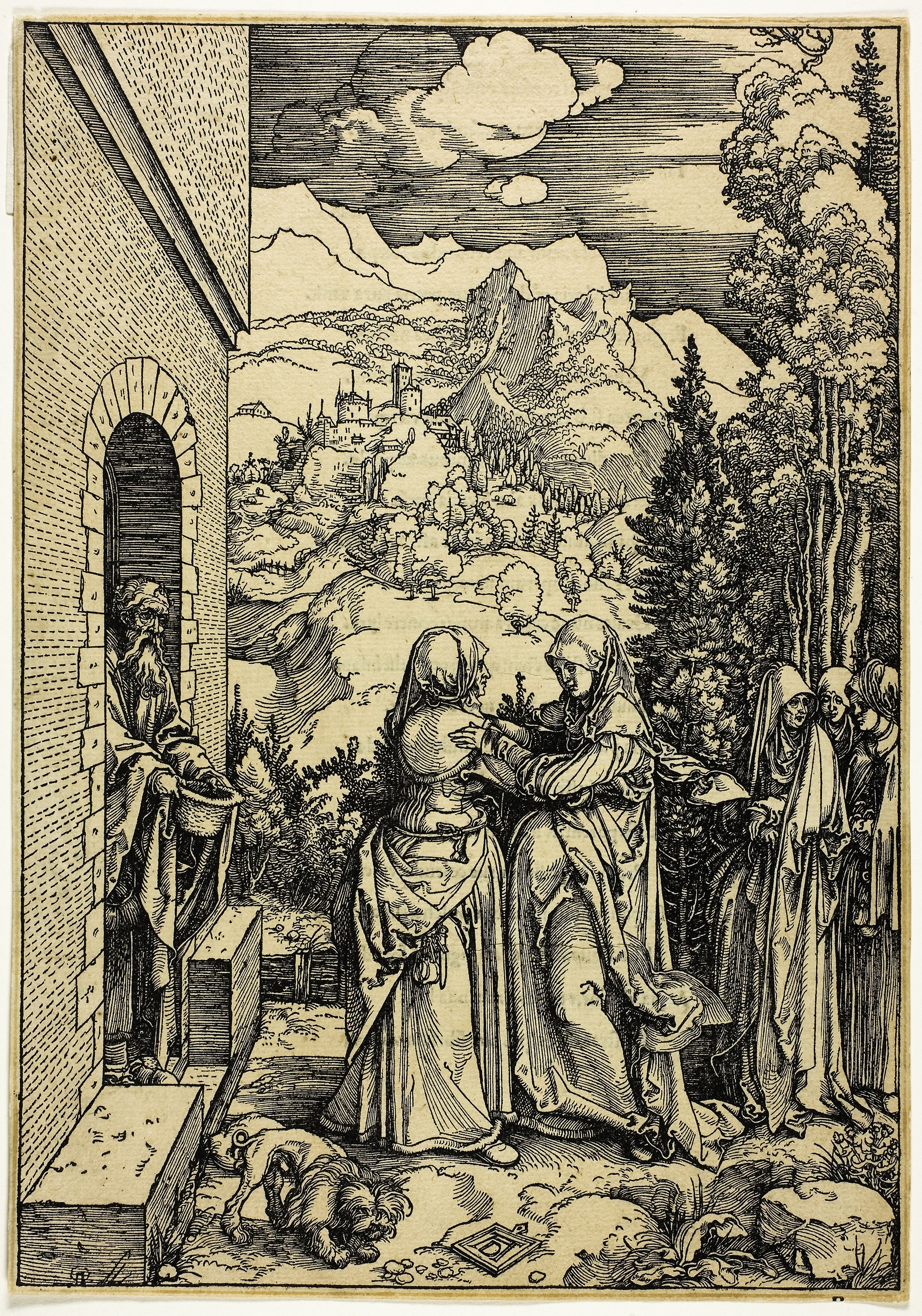
Charity prompts Mary to visit her cousin Elizabeth in the hour of her need. Ah, how the loving heart of our dear Mother anticipates the words of her Divine Son: "By this shall all men know that you are My disciples, that you have love one for another."
"I was sick and in prison and you did visit Me," says our Saviour. And He calls those specially blessed of His Father who shall feed the hungry, clothe the naked, and bring comfort to those that mourn. Wheresoever we move on earth let us, by kindly word and sympathetic action, bring a warm breath of heavenly charity.
St. John the Baptist, in the womb of his mother St. Elizabeth, leapt with joy at the sound of Our Lady's voice, for the voice of Our Lady signifies that Our Lord is near. So we should rejoice to be near to her, and to grow closer to her; for the closer we are to her, the closer we are to Him.
This marks the first time that Our Lord Jesus Christ came to His people; and He chose to do so through Mary, His Mother. Since He came to us by Mary, let us come to Him by Mary, and redouble our efforts and devotion to her and to Him through her.
O Mary, sweet Mother of charity, teach us to be kind; and for the sake of Christ to lighten the burden of Christ's least brethren!

"Wrapped in swaddling clothes and laid in a manger" is Jesus on the night of His birth. The world had forgotten the richness of being poor. It was needful that Jesus should enter into the world in poverty to teach the lesson of detachment from earthly things. In the Crib of Bethlehem, as from the Mount, Christ teaches the self-same lesson: "Blessed are the poor in spirit, for theirs is the Kingdom of Heaven."
If we possess worldly goods, let us act as God's faithful stewards, giving liberally to the poor of Christ; if poverty be our lot, let us not murmur against God's Holy will, but rather thank God we are saved from the many temptations of riches.
Christ, the creator of the universe, the rightful king of Israel and of all that is, chose to come to us as poorer than the poor. Born not in a palace, surrounded by wealth and comfort, but rather in a stable, where brute beasts feed and excrete, rejected by every human person near Him but for His Holy Family. What incredible humility, that the Maker of all permits Himself to be rejected by all to show us how deeply He loves us!
Mary, lover of poverty, teach us to seek first the Kingdom of God.
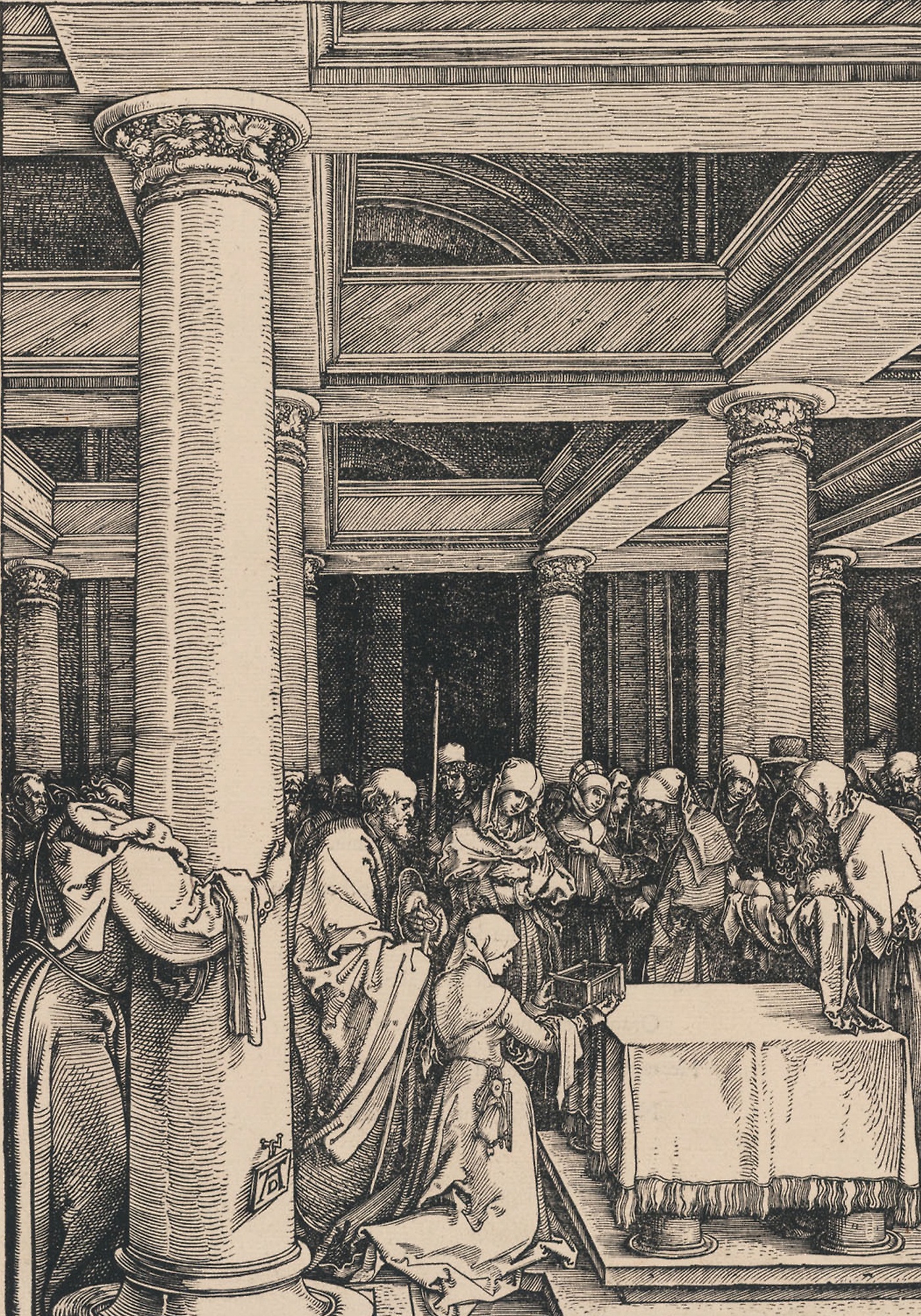
In obedience to the Mosaic law, to which He was not subject, Christ allowed Himself to be presented body and soul in the Temple to teach us that by purity of body and soul we are to consecrate ourselves to the service of God.
"Blessed are the clean of heart, for they shall see God." As we are pure of heart, so will our vision of the things of God be clear. By prayer and the Sacraments shall we maintain purity of life. Prayer will keep our minds in touch with God. Strict examination of conscience will make known to us our faults. The Sacrament of Penance will cleanse our souls. If through the Sacrament of the Eucharist we abide in Christ, Christ will abide in us and keep us pure.
Our Lord Jesus Christ, of course, made the Mosaic law; and yet He submitted Himself to it. What humility for the sake of His people!
By the Mosaic law, the firstborn male of a woman had to be dedicated to the Lord, in honor of the curse of the firstborn which saved Israel in Egypt. The child then belonged to the Lord and to His service, unless he was redeemed for five sicles of silver. (Exodus 34:19-20; Numbers 3:13; Numbers 18:15-16).
Therefore, when Our Lady Mary “brought forth her firstborn son,” she and St. Joseph “carried him to Jerusalem, to present him to the Lord.” (Luke 2:7, 22). It is not noted that they ever paid the five sicles of silver to redeem Him. This is because Christ's life was always dedicated to the Father.
The joy that His birth brought to Israel! Consider Simeon in the temple, “waiting for the consolation of Israel” (Luke 2:25), who burst forth in joy at the sight of Him! Consider the warning Simeon gave to Our Lady, that “thy own soul a sword shall pierce” (Luke 2:35)! Consider Anna the prophetess, fourscore four years old, acknowledging Him as “the redemption of Israel” (Luke 2:38)!
O Mary, Virgin Mother, protect us in body and soul!

Zeal to be about the things that are His Father's prompts Jesus to remain in the pulpit in the midst of the doctors of the law, hearing them and asking them questions. "They that instruct many to justice shall shine as stars for all eternity." (Daniel XII, 3.) How glorious the reward of those who sacrifice themselves for the salvation of souls!
Whatsoever be our station in life, we can work for God by word and example. If our words are holy and of good repute, and our actions are prompted by charity, justice and purity, we are spreading the Gospel of Christ—carrying His message to them that sit in darkness and in the shadow of death.
Think here, too, of the decades of Christ's “silent life”. The years He spent learning His trade from St. Joseph; working with wood, caring for the home, going to the synagogue, laughing with His friends and family, taking His meals and His rest in peace; consider the complete and utter obscurity which our Creator endured for our sake. Consider this example of working on our daily tasks with humility, with dedication, and with love, knowing that He, Who did exactly as we do now, sees it all, knows it all, and rewards it all according to our love. “And he went down with them, and came to Nazareth, and was subject to them.” (Luke 2:51) Consider once again how thoroughly and completely Our Lord humbled Himself for our sakes! The creator of the universe, Who created Mary and Joseph both, “was subject to them.” He submitted Himself to people He had created, to humble Himself as a demonstration of the depth of His love for us, and to give us an example of the love and devotion we owe to our parents!
Consider also that Our Lord here submits Himself to Our Lady and St. Joseph. If they were worthy of the supervision and custody of God Himself, surely they are worthy of the supervision and custody of God's people. Let us submit ourselves to them, particularly to Our Lady, and follow them to their beloved Son, the Son of God, Jesus Christ.
O Mary, zealous lover of souls, teach us to work for God!

In agony Christ prayed: "Father, all things are possible to thee; remove this chalice from me; but not what I will, but what thou wilt." (St. Luke, XIV, 36.) Three times He sent up the self-same cry to His Eternal Father, with earnestness and in resignation to the Will of His Father.
Our Saviour, who had a right to be heard because of His reverence, was constant and humble in prayer, whilst we who have so frequently rebelled against God's will pray with distraction and coldness.
Let us not be like His disciples; for when He asked them to pray with Him, to endure His suffering with Him, three times fell asleep. “Could you not watch one hour with me?” (Matt. 26:40) But He knows our struggles; “[t]he spirit indeed is willing, but the flesh weak.” (Matt. 26:41) Let us strengthen our flesh and our spirit with prayer and fasting, so that we can indeed watch our hour with Him.
In the Garden, during His agony, He was betrayed; indeed, betrayed with a kiss. Even at this moment, Christ reminds us that He suffers only at His own will. “Thinkest thou that I cannot ask my Father, and he will give me presently more than twelve legions of angels?” (Matt. 26:53) He is not taken by force; He submits Himself, by His own Will, to suffer for our sake.
And yet, at this moment, His disciples all fled! (Mark 14:50) Flee not from suffering; remember that we only suffer what He wills, and that He Himself suffered before us and suffers alongside of us! “God is faithful, who will not suffer you to be tempted above that which you are able: but will make also with temptation issue, that you may be able to bear it.” (1 Cor. 10:13) Stay with Him; and remember that this suffering of soul is every bit as painful as the suffering of the body!
O Mary, for whom thy Son didst work a miracle in answer to prayer, pray for us and teach us how to pray earnestly and humbly!
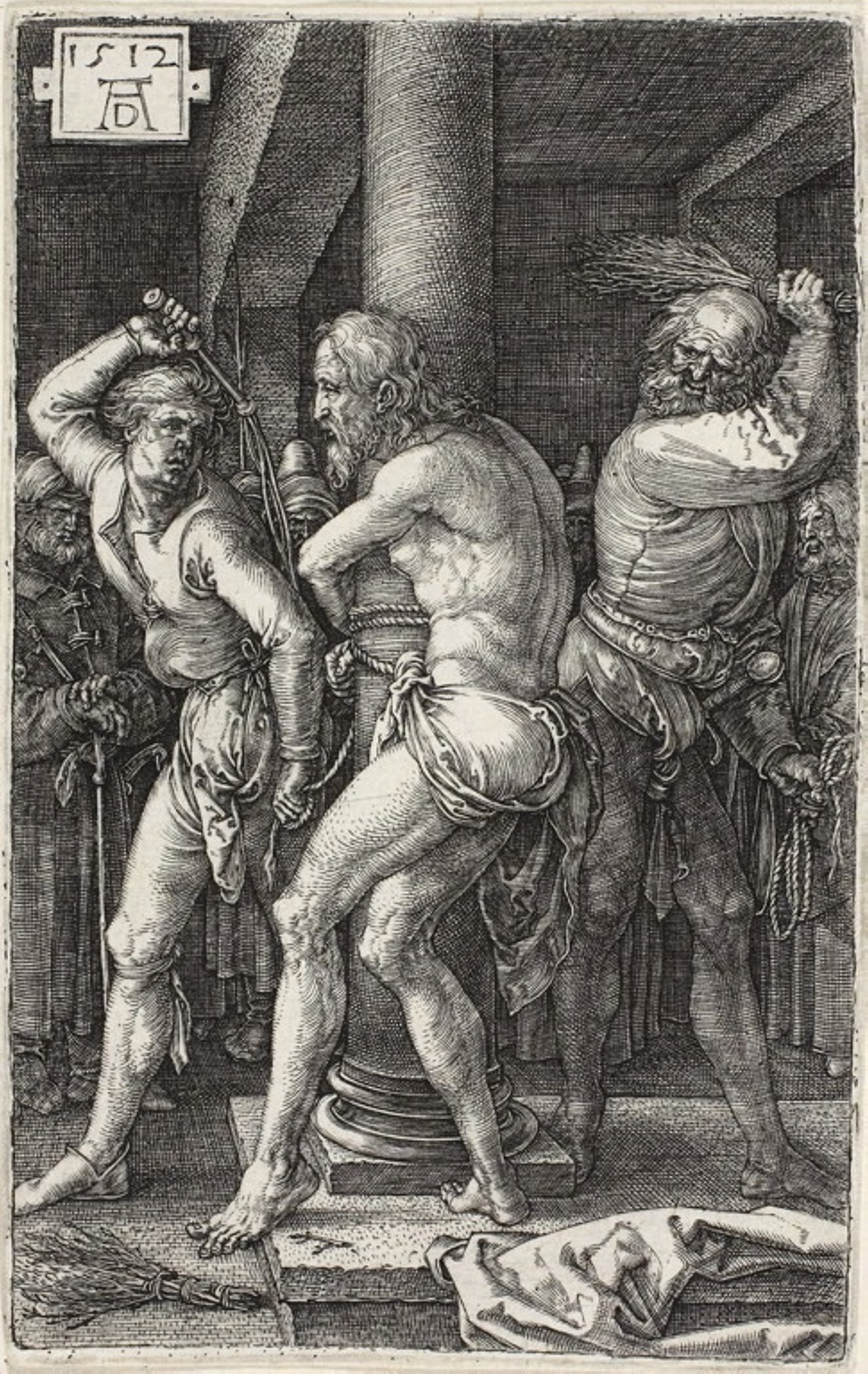
To a world gone mad in the pursuit of pleasure, Christ from the pillar seems to say: "Learn of Me." Standing quivering under the cruel lashes, what a lesson of mortification Christ teaches! Is not every gaping wound in His Sacred Body a rebuke to us who seek to indulge ourselves at all costs—even the cost of our eternal salvation? As we watch the scourging of our Saviour let us bemoan our sins, especially our sins of sensuality.
What an agonizing torture! The Romans, long practiced at the abuse of the human body, knew exactly how to maximize the pain that Our Lord endured; and yet He endured it willingly, without complaint, for love of us! And how patiently He endured, knowing what horrible agonies still lay ahead of Him!
O Mary, Mother of Sorrows, preach to us anew the sermon of St. Paul, who chastised his body and brought it under subjection. "Know you not that your members are the temple of the Holy Ghost who is in you, whom you have from God; and you are not your own? For you are bought with a great price. Glorify and bear God in your body." (I Cor. VI, 19.)
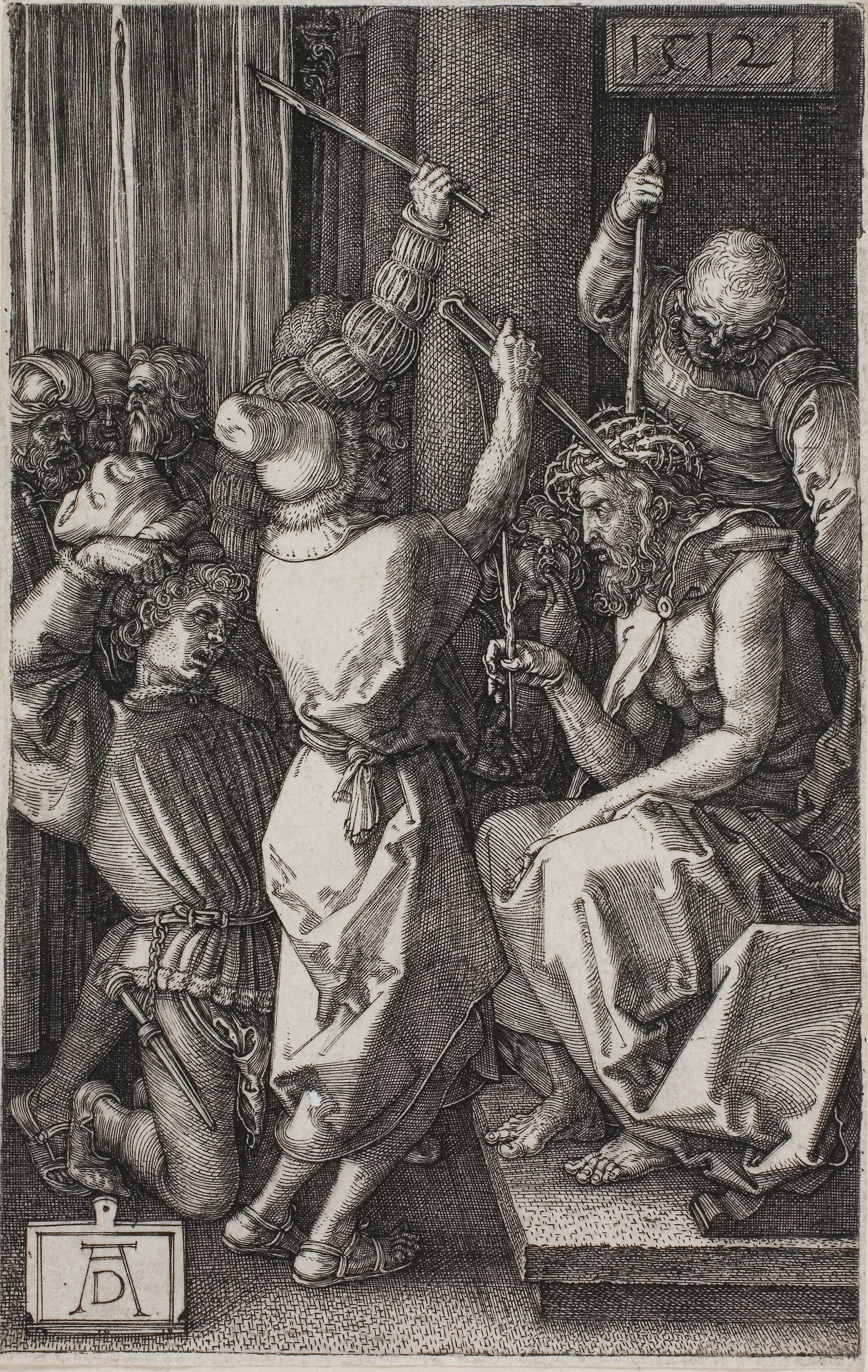
"Amen I say to you, unless you be converted, and become as little children, you shall not enter into the Kingdom of Heaven." (St. Matt. XVIII, 2, 3.) How many times through life has Christ taught the lesson of unquestioning faith! He endures the cruel Crowning of Thorns that we may learn to be humble of intellect. Our earth-bound minds can not measure the things of God, nor solve His mysteries.
With simple faith let us accept the truths God has been pleased to reveal of Himself, praying: "I do believe, Lord: Help my unbelief." (St. Mark IX, 23.) Here note the horrible humiliation that Our Lord permitted to be inflicted upon Himself. He is the Creator of the world, the rightful King of Israel by blood and by act, the true King of the Universe by right of creation, by right of redemption, by right of rule; and that very kingship is used to mock and insult Him! “Thou sayest that I am a king. For this was I born, and for this came I into the world; that I should give testimony to the truth.” (John 18:37) He is our King! He is the King of everything! And yet, “bowing the knee before Him, they mocked Him, saying: Hail, king of the Jews.” (Matt. 17:29) What insult! Shall we also insult Him this way, by denying His rightful kingship?
And He Who rightly wears the crown of rule over everything, was given instead a crown of thorns, an instrument of torture to pierce the flesh on His Sacred Head and to mock the kingship of His Sacred Person! Woe to men, who inflict such torture on the Christ! Let us always give true honor to our true King, and never suffer ourselves to mock Him by denying, implicitly or explicitly, His rightful rule!
O Mary, pray that our faith may be enlivened!
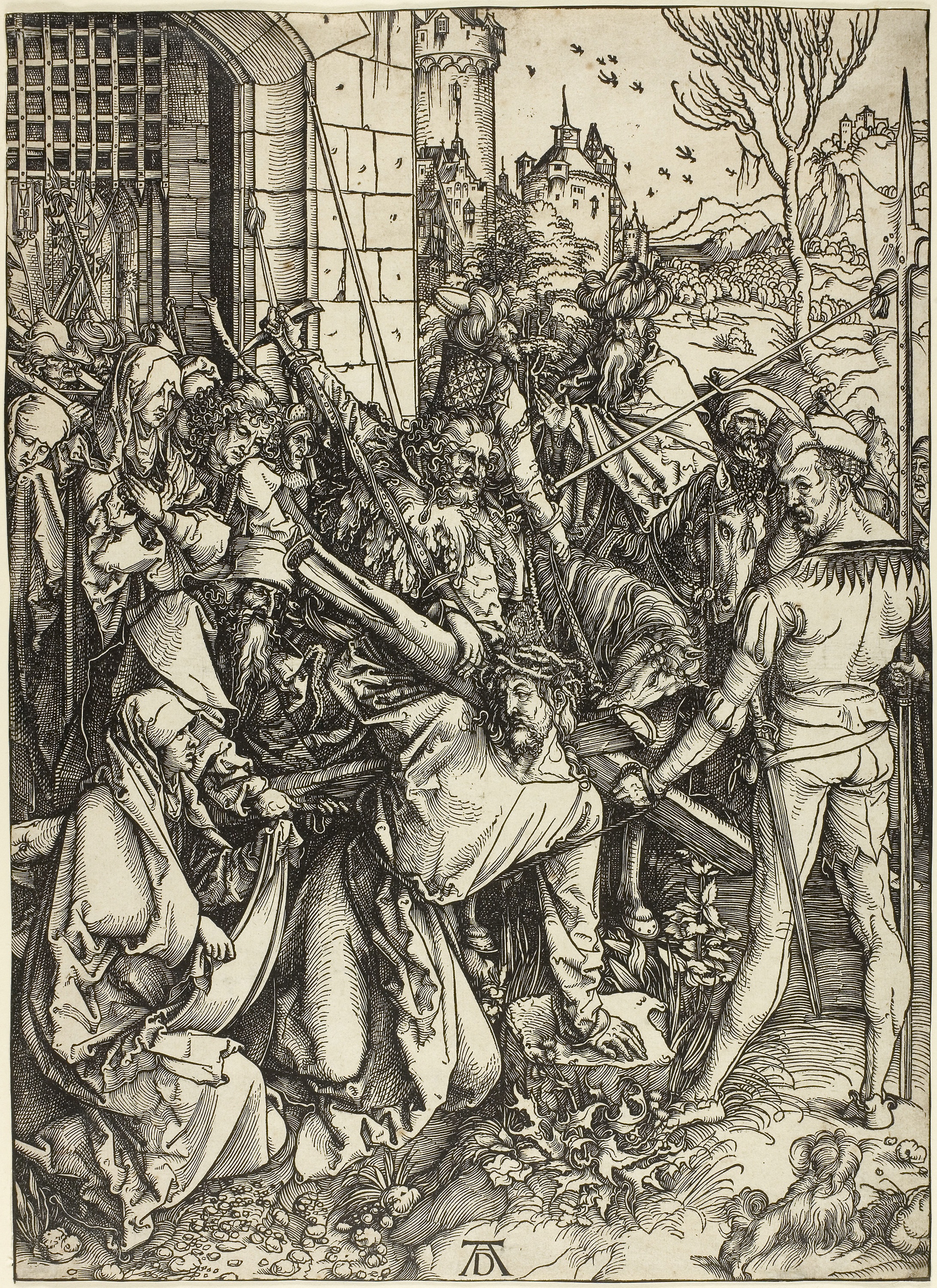
"If any man will follow me, let him deny himself, and take up his Cross and follow me. For whosoever will save his life shall lose it; and whosoever shall lose his life for my sake and the gospel, shall save it." (St. Mark VIII, 34.) True discipleship of Christ is shown by the patience with which we endure our trials. Mark the life of Christ! In sorrow He entered into this world; in sorrow He lived; enduring an agony of sorrow He died.
We wish to follow in His footsteps. Let us accept our trials in humility. We have deserved them for our sins.
Christ bore the weight of the Cross; it is the weight of our sins on His shoulder. Let us not be like Simon of Cyrene, and be forced to bear the cross with Him; let us instead take it up willingly, and eagerly, to suffer along with Him.
O Mary, Mother of Sorrows, teach us to bear the Cross with patience!

"I have a baptism wherewith I am to be baptized; and how am I straitened until it be accomplished." (St. Luke XII, 50.) How strange that the Saviour should sigh for the culmination of His agony—seek in death His triumph! Our human nature shrinks from pain. Yet if our lives are to be Christ-like, we must rather seek to suffer as Christ has taught us by His life of sorrow.
Trials must surely enter into our lives. 'Tis well we accept them as coming from the chastening hand of God to purify our lives and bring us nearer to Himself. Our night of crucifixion will pass, and then will dawn the glorious morning of our resurrection in God.
This is indeed Jesus, the King of the Jews, and the King of all men and all things. And yet He hangs from the cross, sorrowful, miserable, pathetic, dead. Dead for us; dead for our sins. What a tragedy! The whole universe groans and bewails it! “[B]ehold the veil of the temple was rent in two from the top even to the bottom, and the earth quaked, and the rocks were rent. And the graves were opened: and many bodies of the saints that had slept arose…the centurion and they that were with him watching Jesus…were sore afraid, saying: Indeed this was the Son of God.” (Matt. 27:51-54) Even the pagans who physically murdered Him recognized Him for what He was! And yet still we sin; still we grieve Him, knowing that our sins did this to Him, to Him Who loved us so much that he took up this torture willingly, to save us!
Weep, O man, Who by sin has murdered the Son of God! Weep for your sins, and weep for the grace to live true to Him from this day forth!
O Mary, who stood beneath the Cross of thy Son and sorrowed in union with Him, teach us to love the Cross!

We have learned by bitter experience the sadness of sin; we have learned how evil and bitter a thing it is to have forsaken the Lord our God.
Now, rising from the tomb, Christ teaches the mercy of God. He spoke kindly to the sinful Samaritan woman, He protected the woman taken in sin, He received from the outcast Magdalen tokens of her veneration; yea, from the Cross He spoke words of hope to the penitent thief, and prayed therefrom for every wandering prodigal: "Father, forgive them."
Let us take courage, cast off the old man and put on the new, so that the grace of God may abound in our souls.
Christ arose with His Body; but it was clearly unlike the revival of Lazarus, who continued to live with his old body and subject to the old bodily limitations, and eventually would die and pass away. No, this was clearly a glorified body, no longer limited in the way our earthly bodies are. He still had His Wounds—St. Thomas put his finger into them!—but they did not hurt Him; rather they served as another accessory of His glory. He could pass through the locked doors into the upper room; He could appear where and when He willed. This was something fundamentally different from a merely revived body; He was risen gloriously, with a glorified Body, never more to suffer or die. So may we be, one day, if we serve Him well.
℣. Resurrexit! ℟. Sicut dixit! ℣. Alleluia!
℣. He has risen! ℟. As He said! ℣. Alleluia!
This exchange was once a common greeting among the early Christians, so deep and fundamental was the joy of the Resurrection. And indeed, the Resurrection of Christ is the central and fundamental incident of our Faith. “[I]f Christ be not risen again, then is our preaching vain, and your faith is also vain.” (1 Cor. 15:14). All of Christianity rests on this one event: Christ rose from the dead! Man, because of sin, is tormented by death; God, become man, has faced death, confronted it, and defeated it. Now we need no longer fear death; death no longer has dominion over us. He has struck down the Devil; He has struck down death; He has triumphed over all that plagues us here below. Resurrexit! Sicut dixit! Alleluia!
O Mary, teach us gratitude to God who has forgiven us!

"Therefore, if you be risen with Christ, seek the things that are above; where Christ is sitting at the right hand of God. Mind the things that are above, not the things that are upon the earth." (Col. III, 1–2.) How vile everything earthly appears when compared with the beauty of God, the beauty that shall be revealed by God to them that love Him.
If like the saints of old we "walk with God," seeing a reflection of His loveliness in every beautiful thing in life, and abide in His holy presence at all times by turning every thought, word and deed towards Him, we are learning each moment the lesson of Christ's Ascension. Though now we see "darkly and as in a mirror," we are moving steadily forward toward the Divine revelation when we shall see Him face to face, and shall know even as we are known.
For forty days after the Resurrection, Christ remained on earth with the disciples, finishing teaching them what they needed to know, and appearing to many, to ensure that no rational doubt could remain about His Resurrection.
The Ascension puts the cap on the incredible miracle of the Resurrection, and provides us a promise of the glorious future that awaits those who love Him. Men have been risen from the dead before; they continue their lives, but then die and are buried in the usual way. But Christ's Resurrection is not the same, and the Ascension demonstrates that. He has risen permanently; He has risen never again to die; He has defeated death, now and forever. And so He went up into Heaven, with the Body that He raised.
As He went up into Heaven, He promises that we might one day follow Him; at first with our souls only, but then at the last day with our bodies, as well, just as He took His Body with Him. And “eye hath not seen, nor ear heard, neither hath it entered into the heart of man, what things God hath prepared for them that love him” (1 Cor 2:9). What generosity! What mercy, to so bless those who so recently committed such horrible crimes against Him!
O Mary, teach us always to realize God's holy presence!
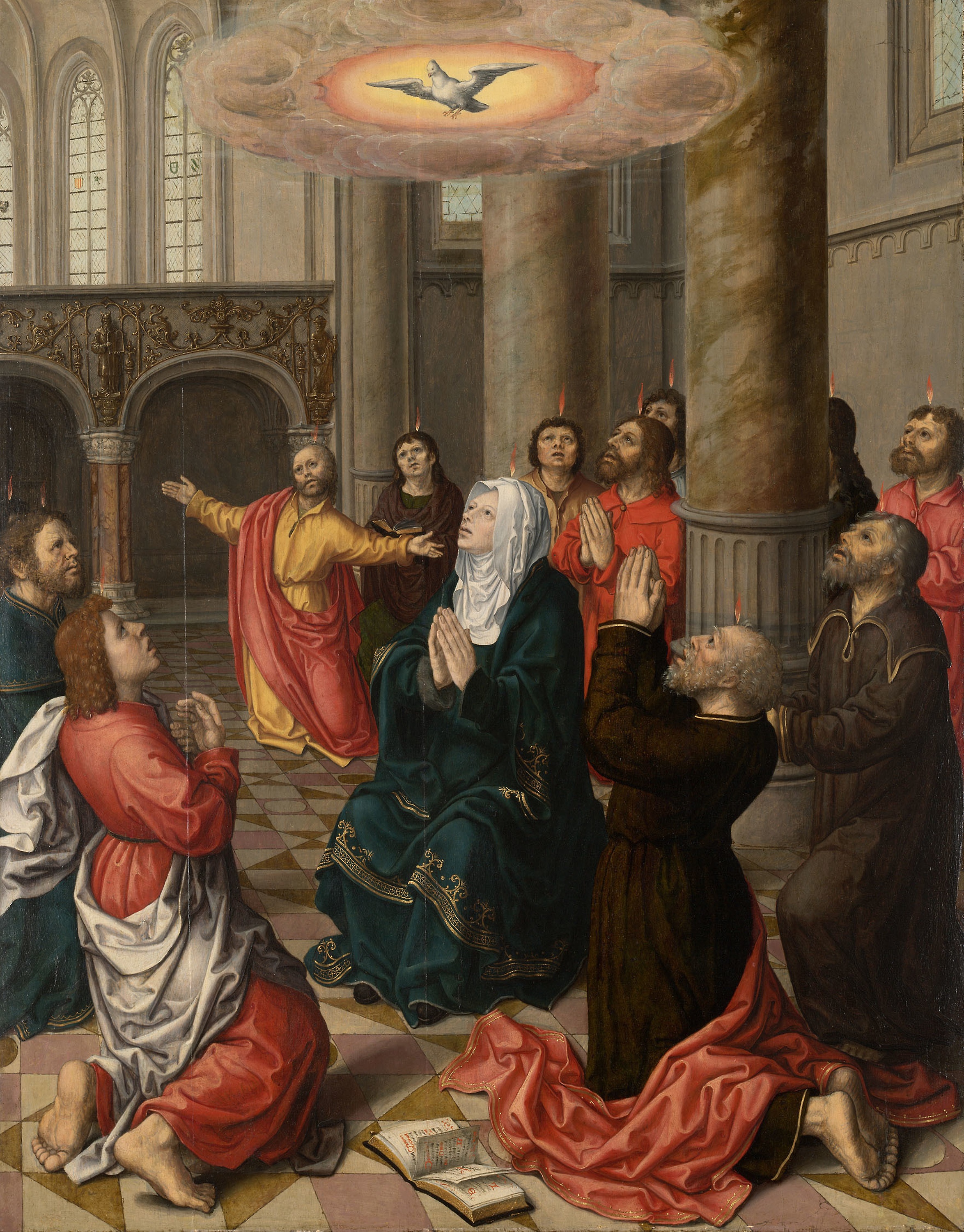
To know, to love, to serve God—there is our life's work: to know Him through the works of His hands; to love Him for His tender mercies towards us; to serve Him by obedience to His holy law. In fulfilling the duties of our station in life we are called upon to make sacrifices. Under the guidance of God's spirit let us sacrifice with a good heart, mindful that God loveth a cheerful giver. It may be that God shall say: "Friend, go up higher." "Go sell all that thou hast and give to the poor and come and follow me." Should God summon us to heroic work for His sake, let us obey.
Up to this moment, the Apostles had waited. Already ordained bishops, already charged with spreading the Faith, they needed strength and courage; they needed “another Paraclete, that he may abide with you for ever.” (John 14:16) And with the Holy Spirit upon them, they were aflame with His zeal, and “began to speak with divers tongues…that every man heard them speak in his own tongue.” (Acts 2:4, 6). These men went on to teach the Faith of Jesus Christ across the whole of the known world, and even beyond it, into places that even the Roman Empire had never dreamed of reaching; into Parthia, into India. And even into Rome itself.
This is the birthday of the Church. See what greatness the Spirit will work within us, if we open ourselves to Him and let Him inspire us to great works!
O Mary, spouse of the Holy Spirit, teach us to obey heavenly inspirations!
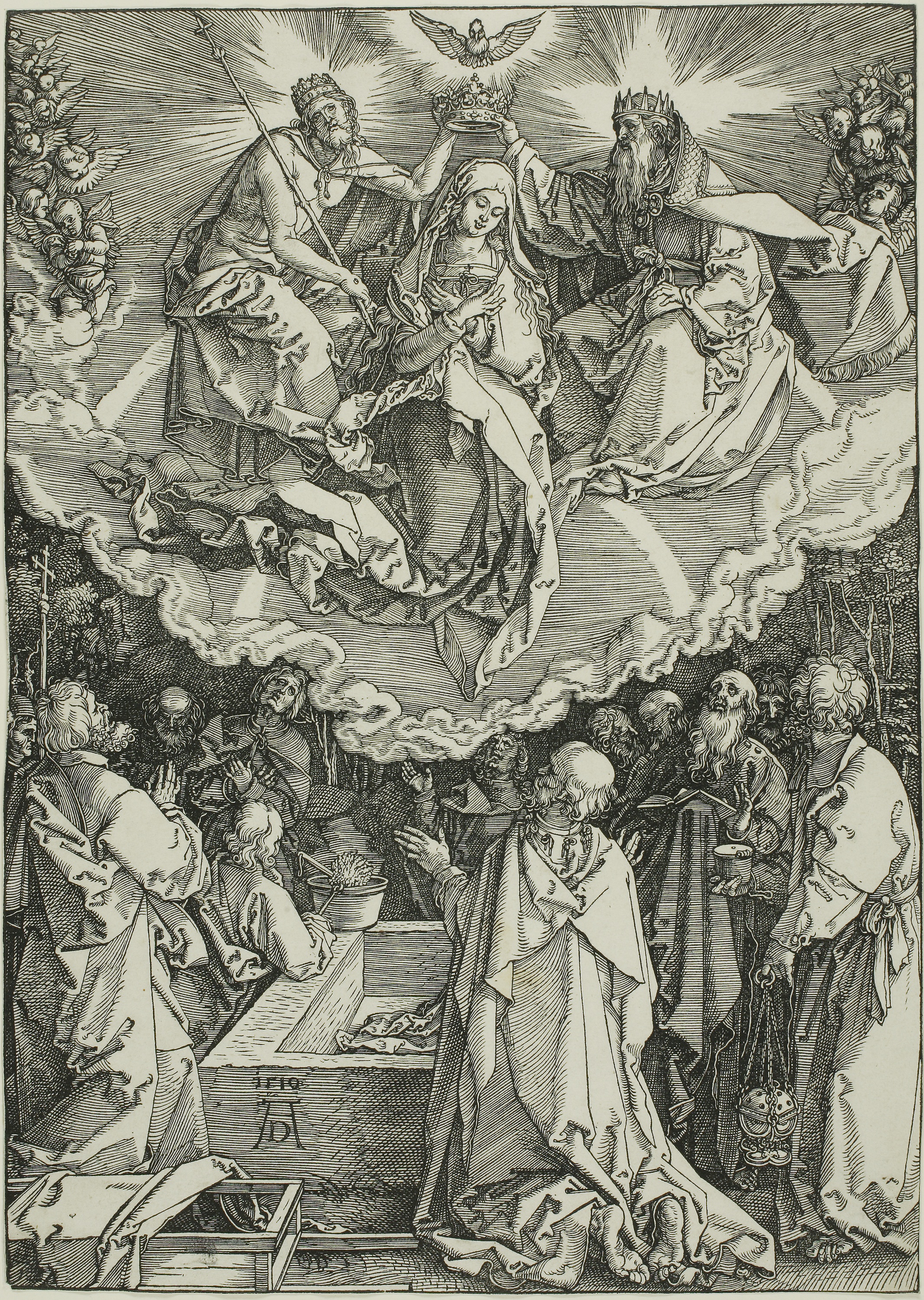
We have admired Mary's intimate union with her Divine Son, her tender watchfulness, her sweet motherly sympathy, her glorious co-operation in the sacred work of the Redemption. Now that He has ascended into heaven, she cannot endure separation. Her ardent love seeks union with the dear object of her love. By God's will is she borne body and soul to Heaven.
While we are on earth let us strive to be united with God by a bond of charity, which shall increase as the years go on, and find its consummation in the heavenly presence.
Death is the punishment of original sin; but Our Lady did not have original sin, so she should not suffer its penalty. Our Lord could not bear His own Mother decomposing in the ground, like we who have offended Him so many times. No; she who was sinless was brought up to Heaven without suffering death.
On the Cross, He entrusted us all to His Mother as to our own—“Woman, behold thy son…Behold thy mother” (John 19:26–27). What a Mother He has given us! Praise Him, Who has given us all things!
O Mary, intense lover of God, teach us to love but God alone!

"He that shall persevere unto the end, he shall be saved" (St. Matt. X., 22). Mary has entered into her reward, and is crowned with glory. We still are in the vale of sorrows, still tempted unto sin. "But God is faithful, who will not suffer you to be tempted above that which you are able: but will make also with temptation issue, that you may be able to bear it." (1 Cor. X., 13.) This thought should steady us in all our trials.
The world may tempt us with its vanities; the flesh may tempt us with its sensualities; the devil may tempt us with his pride; but neither world nor flesh nor devil will be stronger than God's grace that shall be ours in answer to earnest prayer.
The mother of the king is naturally an important figure; and the Scriptures show us that she was particularly important in Israel and Judah. King Solomon even “bowed to” his mother, and “a throne was set for the king's mother, and she sat on his right hand,” and when she said she had something to ask him, he said, “My mother, ask: for I must not turn away thy face” (1 Kings 2:19–20). And a whole chapter of Proverbs consists of the wisdom of a queen mother given to the king (Proverbs 31).
Our Lady knew likewise. She is the queen mother; and even when Our Lord rebuffed her—“Woman, what is that to me and to thee? my hour is not yet come”—she simply said to the waiters, “Whatsoever he shall say to you, do ye.” (John 2:3–4) She knew that He would not and could not deny her. So she, Queen of Heaven and Earth, will not and cannot be denied by Him, Who sits at the right hand of the Father. She is the queen mother; she will always intercede for us with the King. And wherever she is honored as Queen, He will be—must be—honored as King.
O Mary, crowned with glory in Heaven, pray that we may be worthy to be crowned like thee!
